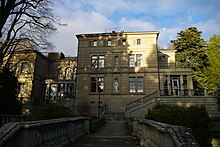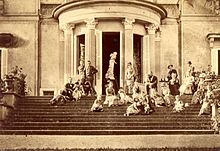Bad Schachen
Schachen is a district of the large district town of Lindau (Lake Constance) .
geography
Schachen is located directly on the shores of Lake Constance in the southwest of the mainland urban area of Lindau. In the west, Schachen borders on Wasserburg and in the north on Bodolz . The Lindau districts of Aeschach (also on the shores of Lake Constance) and Hoyren are to the east and northeast .
Attractions
In Schachen there are some well-known villas and country houses on the shoreline.
Hotel Bad Schachen
47 ° 33 ′ 28.2 " N , 9 ° 39 ′ 56.6" E
With the discovery of an iron-sulfur spring in 1474, a small medicinal bath was built here near the lakeshore and was continuously expanded in the following centuries. In 1752 the property came into the possession of the Schielin family. From 1853 onwards, when the Munich – Lindau railway line opened, many visitors came to Lake Constance.
Between 1909 and 1910 a new building was built by the two Art Nouveau architects Hermann Billing and Wilhelm Vittali from Karlsruhe. From 1922 to 1931, the building complex was expanded by Max Littmann from Munich and in the course of this, the Bad Schachen lido was built in place of a wooden bathhouse that had previously been in this area.
In 1937 the hotel facilities were expanded again, during the Second World War the hotel served as a rest home for the Air Force and after the end of the war, initially as a holiday home for the French occupation troops, until hotel operations could be resumed normally in 1949. The hotel has a landing stage for Lake Constance shipping .
Alwind Castle
47 ° 33 ′ 31.1 ″ N , 9 ° 39 ′ 12 ″ E
The Alwind (or Allwind) property was first mentioned in a document in 1370 and was previously owned by the
- Lords of Höchst (in the 15th century): Johann von Höchst from Lindau built a castle-like castle in 1455, which he called "Alwind".
- Lords of Montfort
- Johann Baptist Ritter von Spix (1781–1826) was honored by the king for his services. He was probably no longer able to visit Alwind Castle on Lake Constance, which he had received from the king as a gift.
- Herren von Gruber (from 1797): Georg Gruber was a cousin of Friedrich Gruber and he had a villa built for himself as a summer residence a few hundred meters west of the Lindenhof. Villa Alwind was built between 1852 and 1853 as a classicist villa with a flat hipped roof by the architect Johann Christoph Kunkler from St. Gallen.
- Leopold König (1852–1912): In 1905 the textile industrialist König bought the house after it had been uninhabited for over 50 years. During the "King's Era" between 1905 and 1912, Alwind became a center of social life in Lindau during the summer months. In 1906 the Alwinder harbor was built here - based on the model of the Lindau harbor with two piers, one of which has a lion statue.
- Dr. Paul F. Beckmann (1881–1963): Beckmann bought the property in 1924 and had the park built in place of the vineyard south of the villa.
- Deutsche Post AG (from 1937): From 1942 the building complex was used as a rest home for female postal workers. After the Second World War, the system went to the French occupation forces and was returned to the Deutsche Bundespost in 1951. The villa and the park were listed as a historical monument in 1952 and are now used as a recreation facility by Post-Postbank-Telekom.
Lindenhof villa, park and bathroom
47 ° 33 '28.3 " N , 9 ° 39' 39.4" E
- Lindenhofvilla
This stately villa was built between 1842 and 1845 by the Munich architect Franz Jakob Kreuter for the Lindau merchant Friedrich Gruber (1805–1850), who had made his fortune in Italy, on the Schachen lake shore with the surrounding Lindenhof park. The Lindenhofpark is the most important park on the Lindau villa bank by its size alone, with the avenue of lime trees on the bank wall.
The lavishly restored villa is now owned by the city of Lindau and is used in various ways: in addition to private use, the salon rooms host cultural events several times a year, e.g. B. the “Long Night of Literature” in May. In the east wing, the villa is now home to the Lindau Peace Museum (Peace Rooms).
- Lindenhofbad
The Lindenhofbad is located on the edge of the Lindenhof Park on the shores of Lake Constance. This outdoor swimming pool was built in the late 1950s and has a central building of high architectural quality. It was opened to the public in 2012 and has been free to visit ever since.
- Lindenhof Park
The park at the Lindenhofvilla is freely accessible and in summer the lake access is used by bathers.
In 1332 a two-story castle house with a gable roof was mentioned here on the lake shore with the Degelstein Castle ("Tegelstein"). The complex was demolished in 1839 and today only the remains of the wall of the Weiherschlösschen in the area of the Lindenhof Park are preserved.
The following owners are known:
- Family Haintzel (1332)
- Lindau women's monastery (1385)
- Cornelius von Kirchen (around 1592)
- City of Lindau (1621)
- Friedrich Gruber (1839)
- City of Lindau (1956)
Villa Wacker
47 ° 33 '25.6 " N , 9 ° 40' 30.8" E
The castle-like Villa Wacker was built in the late historical style between 1900 and 1902 with Nuremberg red sandstone on the lakeshore for the entrepreneur Alexander Wacker (* 1846; † 1922). The property is divided by Schachener Strasse and to the north of it are the outbuildings such as stables and the coach house.
Inside the building, three Art Nouveau rooms were furnished by Peter Behrens . In 1909 the roof structure and the upper floors of the villa burned out and were rebuilt in their original form. Elisabeth Wacker died in 1938 and the building was only temporarily used until the French General Jean de Lattre de Tassigny moved into it on May 12, 1945 after the Second World War .
In the 1950s, the villa was used as a rest home for Wacker Chemie employees and as a Caritas home until 1984.
The building was renovated in 1985, and since 1986 it has been owned by the entrepreneur Uwe Holy , the former owner of Hugo Boss and grandson of the company's founder, Hugo Ferdinand Boss .
Schachen-Schlössle
47 ° 33 '38.5 " N , 9 ° 40' 2.6" E
This castle was built at the end of the 15th century and at that time served to secure the free imperial city of Lindau. The very well-preserved building complex has housed a restaurant since 1950.
Web links
literature
- Lucrezia Hartmann: Villa Alwind. "Perle am Bodensee" , in: Writings of the Association for the History of Lake Constance and its Surroundings , 129th year 2011, pp. 155–180 ( digitized version )
- Christoph Hölz, Markus Traub: Wide views - country houses and gardens on the Bavarian shores of Lake Constance . Deutscher Kunstverlag , 2009, ISBN 978-3-422-06800-1 .
Individual evidence
- ↑ Johann Baptist Ritter von Spix
- ↑ Source: Monuments in Bavaria, KDMVII; Heinrich Habel, Helga Himen; Volume VII. Schwaben, Munich 1985
- ↑ Where once 20 Arabs stood (SZ, October 29, 2008)
- ↑ Holiday complex: Post building in Alwind (SZ, November 6, 2009)
- ↑ Expensive living space (Der Spiegel 39/1990)
Coordinates: 47 ° 34 ' N , 9 ° 40' E






